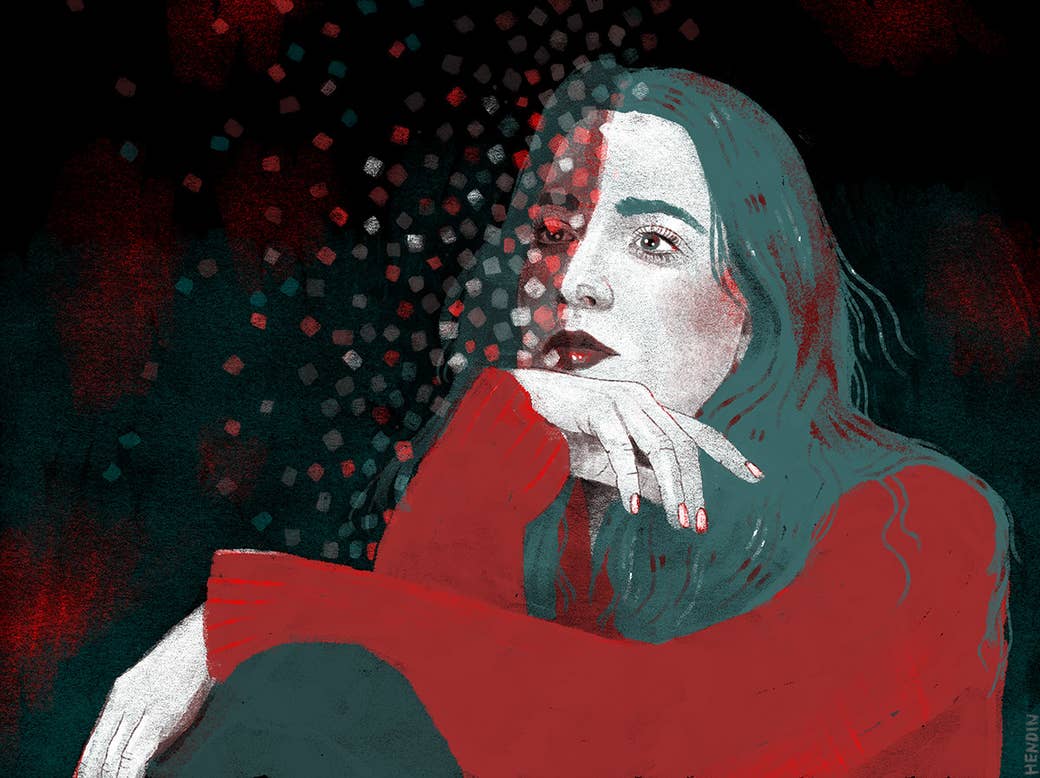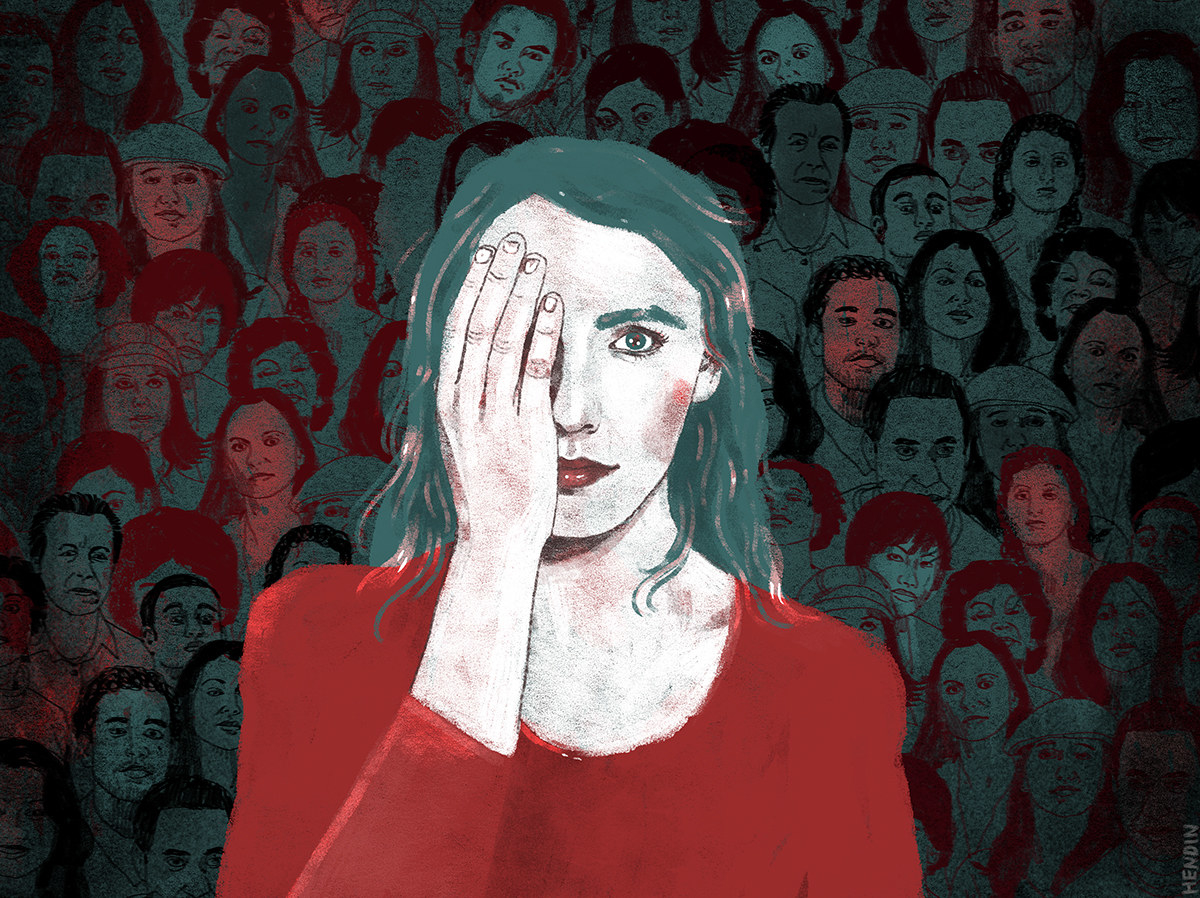
On a random December day in 2008, half my face got paralyzed.
I was in the middle of my graduate program in journalism in New York and — having arrived straight from college — I took it very seriously. I was determined to meet my deadlines, spend a lot of time at the bar with my classmates, and fully enjoy my first winter in the city.
The end of the semester was near and I had a lot of stuff on my plate. I was finishing up my final project in a class taught by a very demanding professor: a story about a murder for which I had gone to an upstate New York maximum-security prison to talk to a woman nicknamed “Lovely” who had a man killed by two friends and a cousin after having sex with him. Lovely wouldn’t tell me anything during our encounter; she wasn’t “feeling it.” The only thing she asked me was if I could buy her a bag of Doritos from the vending machine.
I was also working on a big project about female firefighters in New York City, and was scheduled to attend the Fire Academy’s graduation to see some of the girls graduate.
And finally, I was about to co-host “Lucille’s Ball,” the annual winter party at the journalism school — an event that tries to be something between a roast and a gala — together with a very serious German classmate.
I had been a bit sick earlier in the week — just a simple winter virus — but I was feeling fine. What I needed were vitamins, water, and sleep. Surely I’d power through it like many times before.

About 24 hours before the day of the party and the deadline of my Lovely story, I woke up and looked in the mirror. Something was off. Hmm, weird, I thought. Why does my face feel different for some reason?
I quickly convinced myself that it was all in my head and went to school for a full day of writing.
In the afternoon, I ran into my friend and classmate Matt. I had spent hours holed up in a classroom and hadn’t yet returned to a mirror.
He greeted me with a “Jesus, what happened to your face?”
Matt’s very direct.
“You have Bell’s palsy!” he immediately continued and he proceeded to tell me about a college buddy of his who had it too and it was “so hilarious” because beer dribbled out of the corner of this poor dude’s mouth for months, ha ha ha.
I brushed him off and told him he was a jerk, but I still got myself to the nearest bathroom for some serious inspection.
For the first time that day I took the time to examine what I saw: I looked like someone who had suffered a stroke. The left side of my face was motionless. Puffy. Red-cheeked.
I tried raising my eyebrows. Only the right one went up.
I tried smiling. A lopsided grimace was the result.
I tried blinking. My left eye wouldn’t do it.
A doctor at the campus health center quickly diagnosed me later that day. It turned out Matt was right. (About a week later, at a friend’s holiday party, Matt would announce my arrival by yelling that the “Phantom of the Opera” had arrived. Miraculously, we remained friendly after graduation.) Apparently I was a “classic case.”

I had endless questions: How did this happen? How long would it last? What could I do to make it go away quickly? I had a party to host tomorrow – would it be gone by then? But the doctor didn’t have any answers. In his defense, there really weren’t many answers to give. He told me there’s no cure. He prescribed me some meds, referred me to a specialist, and sent me home.
A Google search educated me on my sudden and unexpected ailment. Bell’s palsy — named after Sir Charles Bell, the 19th-century Scottish surgeon who discovered it — causes temporary weakness or paralysis of the muscles in one side of the face. (Very rarely it can occur on both sides, says the internet.) It’s most common in people between 15 and 60. While the exact cause is unknown, it’s believed that Bell’s palsy happens when the nerve that controls the muscles in your face becomes compressed, likely — but not definitely — after it becomes inflamed due to a viral infection. (Maybe I had underestimated that winter virus from earlier in the week after all. )
My search for answers morphed into a search for promises it would be OK. But as I trawled through YouTube, videos of people in my same predicament sent me into a raging panic attack. Apparently 3 out of 10 people never fully recover. Some people’s faces are paralyzed forever.
That night I wrote to my friend from college, trying to mask my panic by using a lot of ALL CAPS for comic effect:
This morning when I got up my face was acting weird – as in the left side was numb, and this afternoon my left cheek started swelling up, so I went to the health center, and a (huge douchebag of a) doctor told me that I have Bell's palsy, which causes your face to go numb for a while. WHICH SUHUCKS. because, 1) I can't smile (HELLO MY TRADEMARK), 2) It took 3 hours out of a night before a 3,000-word deadline 3), tomorrow is the big J School Party and I am the host... What if I look like Willy the Walrus?!
To my professor later that evening, I also put up a hopeful front:
There isn't any cause for concern, my face will fully function again, the question is just: when?
To my friends in the Netherlands:
When I smile (I’m continuing to smile) only the right side of my face works. When I raise my eyebrows, only the right one goes up while the left one does NOTHING.
Looking back at these emails, the number of all-caps and exclamation marks and insertions of things like “ha ha it’s gonna be totes fine YAY but this is kind of sucky ha well anyways what’s up with youuuuu??!” makes me sadder than I allowed myself to be back then.

I handed in my Lovely story on time.
I hosted the party in front of the whole school. I’m conspicuously absent from that evening’s Facebook albums (we’re talking about 2008 here; Facebook albums were still a thing).
The only documented proof of my Bell’s palsy are three pictures of me from that night — and they’re fairly well hidden in the untagged corners of the internet — in which I awkwardly hide my face with my hand.
The following week, I covered the New York City Fire Academy’s graduation — more than 200 young, handsome firemen in uniform and I couldn’t smile at a single one of them.
I went on with my life as if nothing was wrong, but on the inside I was losing patience. Every morning when I woke up, I hoped I’d be better and that I would look like myself again. Yet every day, my reflection continued to be lopsided and my left eyebrow was still on strike.
I tried to remain calm and optimistic, but I was very worried that either my face would never fully recover, or it would take a very long time to heal.
I could hardly think of anything else. When I was in public, I sensed people doing a double take. I could almost hear them thinking hmm, something ~weird~ about her face. I stressed about all my interactions — from the cashier at my local pharmacy to my classmates and everyone in between — wondering what the other person was thinking while looking at me.
I had never been in a position where people take that extra split second to inspect you — clearly wondering what exactly about you is “off” while trying to act as naturally as possible. I had never appreciated my fully functioning face or my ability to smile my way through almost any situation (and with that, the privilege of often getting what I want). Never before had I been this conscious of and this obsessed with how I looked.
I started resorting to fantasies to keep my mind entertained. What if I walked into a bar and saw — from across the room, obviously — a cute guy and the other half of his face was paralyzed and we’d just walk toward each other to immediately lock our barely working faces into a lopsided kiss?
Roughly 40,000 Americans develop the condition every year. I didn’t meet or kiss any of them at a bar.
One day I bought high, sexy (read: incredibly uncomfortable) heels and asked for a discount at the cash register. “Half my face is paralyzed and it’s almost Christmas!” I said, nearly in tears out of sheer frustration and in dire need of something to control. The guy in the store didn’t know what to do with me, so he gave me 10% off. I never wore the shoes.
I went home to Amsterdam for Christmas break and when my mother saw me she immediately burst out crying in the middle of the airport’s arrivals hall.
“Look at it this way,” my brother said, hitting that rare perfect balance between sympathy and humor, “your face is half not paralyzed.”
I developed a way to laugh, basically by turning away from people and placing my hand over the left side of my mouth. I accepted that contact lenses were off the menu for a while and went back to wearing glasses full time.
And I spent much more time than usual looking at myself in the mirror, inspecting every inch of my face.

While the arrival of Bell’s palsy had been unexpected and instantaneous, the recovery process was gradual and tedious. Throughout December and much of January, I continued to stare in the mirror longingly every morning, raising my eyebrow(s), hoping that the tiniest perceived change meant that I was getting my face back.
My worries about the long-term implications — it’s very hard to ignore thoughts like what if I’ll look like this forever? — didn’t fade until much later, but about six weeks in, my nerve decided to slowly start functioning again while I kept on performing what I called “the eyebrow test” multiple times a day. (That test is me staring at myself while raising my eyebrows and measuring their movement over and over and over and over again.)
With the return of my facial muscles came the return of my confidence and actual optimism. I started posing for pictures again. People stopped looking at me funny. My smile returned, as did my confidence and my desire to go out and meet people. Once the real healing was set in motion, life quickly returned to normal.
In the end, it took about three months until I was totally myself again. I’m convinced my face is forever somewhat asymmetrical, but I don’t think that’s visible to anyone but me.
Friends still bring it up sometimes: “Hey, remember when your face was paralyzed?”
Oh yeah, I remember.

A couple of years ago, I was sent this excellent New Yorker piece about a man with incurable Bell’s palsy. It thankfully hadn’t come out yet when I had the condition — it would have sent me into a tailspin. I’ll never forget those haunting YouTube videos by the people who dealt with this for far longer than I did.
It’s been eight years and I barely think about it anymore. I stopped monitoring my eyebrows a long time ago and I’ll admit that I take my fully functioning facial nerves for granted most of the time.
But not all the time. For years, I smiled as wide as I could at every New York City fireman I came across.
